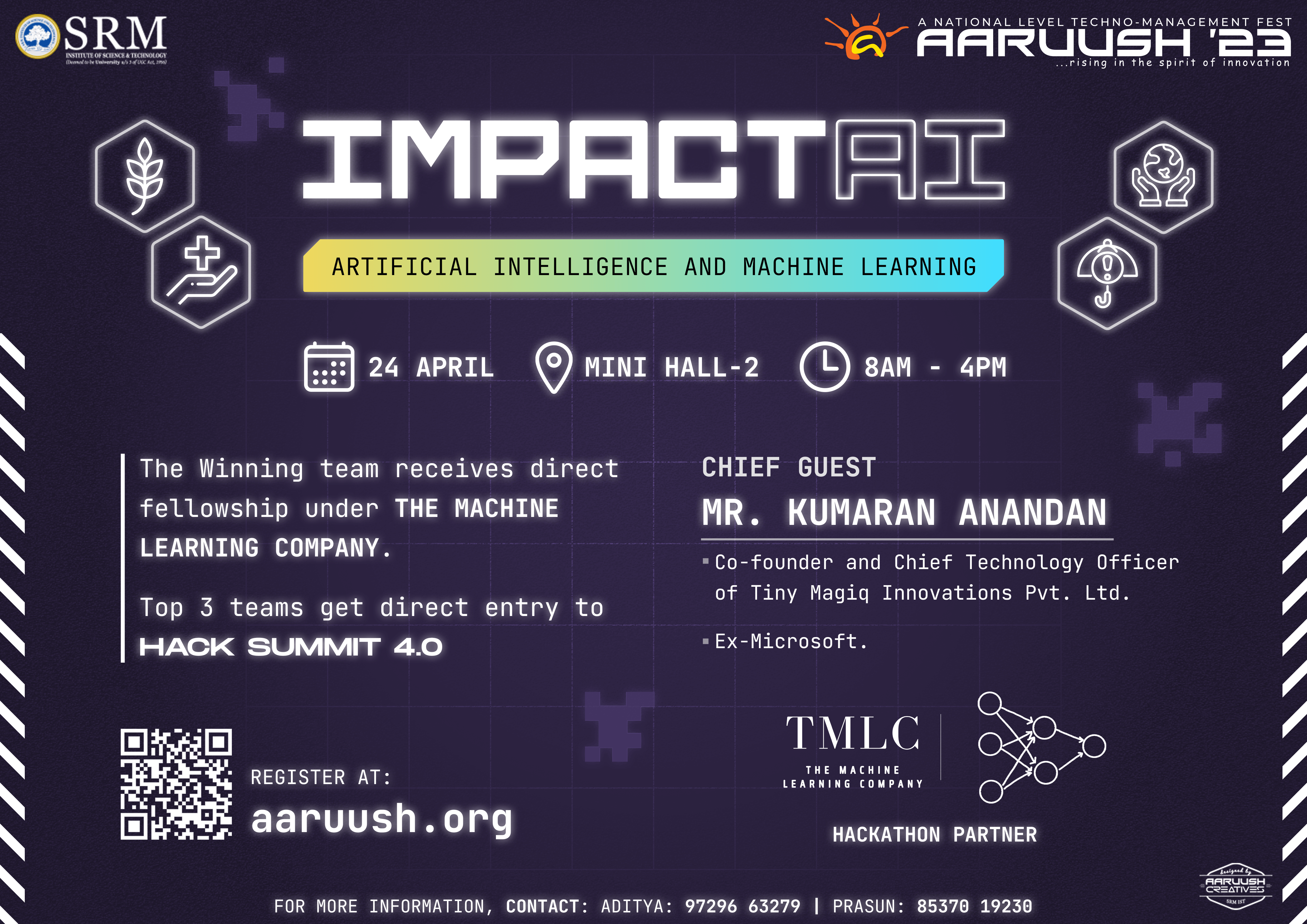ImpactAI
Coding for a better World

- AboutArtificial intelligence and machine learning: With the increasing use of AI and machine learning in various industries, hackathons focused on developing AI-based solutions for areas such as healthcare, finance, and logistics may become more prevalent. Teams of 3-5 members collaborate to create a functional software or hardware product within a set time limit. Competitors' capabilities are evaluated in various areas, including technical expertise, mental toughness, ingenuity, problem-solving abilities, public speaking and presentation proficiency, time management, resource allocation, and business acumen.
- Structure
Problem Statements
-
Reducing food waste: Develop an AI-powered solution that helps farmers and food distributors to better predict supply and demand, reducing food waste and ensuring that surplus food goes to those who need it.
Challenge: According to the United Nations, one-third of all food produced in the world is wasted, which amounts to approximately 1.3 billion tons of food every year. Food waste not only contributes to global greenhouse gas emissions but also represents a significant loss of resources, including water, land, energy, and labor. Furthermore, food waste disproportionately affects vulnerable populations, such as those experiencing food insecurity.
Objective:
Develop an AI-powered solution that enables farmers and food distributors to reduce food waste and ensure that surplus food goes to those who need it.- The solution should be able to predict supply and demand accurately, identify the optimal times and locations for food distribution, and provide real-time data and insights to help farmers and distributors make informed decisions.
- The solution should also incorporate innovative approaches to reducing food waste, such as food recovery, composting, or recycling, and enable cross-sector collaboration among stakeholders in the food supply chain, including farmers, distributors, retailers, and consumers.
- The solution should be scalable and adaptable to different contexts, including urban and rural areas, and should aim to create positive social and environmental impact while also being financially sustainable.
-
Protecting endangered species:
Objective: The problem statement is to develop an AI-powered solution to protect endangered species and their habitats by analyzing satellite imagery and other data sources to identify and monitor potential threats, such as deforestation, poaching, and habitat loss. The solution should provide real-time alerts to conservationists and park rangers, allowing them to take proactive measures to prevent harm to endangered species and their habitats. The solution should also leverage machine learning algorithms to predict potential threats before they occur, enabling more effective and efficient conservation efforts.
Challenges:
Data availability and quality: One of the key challenges in developing an AI-powered solution for protecting endangered species is the availability and quality of data. While there is a lot of data available on endangered species and their habitats, it can be difficult to access and may not always be accurate or up-to-date.
Identifying potential threats: Another challenge is identifying potential threats to endangered species and their habitats. There may be many different factors that contribute to the decline of a species, and it can be difficult to distinguish between natural fluctuations and human-caused threats.
Real-time monitoring: Monitoring endangered species and their habitats in real-time is essential to prevent harm and take timely action, but this can be challenging in remote or inaccessible areas where traditional monitoring methods are not effective.
Ensuring privacy and security: Another challenge is ensuring the privacy and security of sensitive data, such as the location of endangered species, while still making it accessible to conservationists and park rangers who need it to take action.
Cost-effectiveness and scalability: Finally, it's important to develop a solution that is cost-effective and scalable, so that it can be implemented in different regions and for different species, and not limited to a single location or species. This may require balancing the use of sophisticated technology with more traditional conservation methods.
Overall, the development of an AI-powered solution for protecting endangered species requires careful consideration of these and other challenges, as well as a collaborative approach that brings together experts from different fields, including conservation, technology, and data science.
-
Improving disaster response: Develop an AI-powered system that can quickly analyze satellite imagery and social media data to identify areas affected by natural disasters, allowing aid workers to prioritize response efforts and provide assistance to those in need more quickly.
Objective: The objective of this problem statement is to develop an AI-powered system that can rapidly identify areas affected by natural disasters, such as floods, wildfires, or earthquakes, using a combination of satellite imagery and social media data. By identifying areas that have been impacted by a disaster in real-time, aid workers can prioritize their response efforts and provide assistance to those in need more quickly, potentially saving lives and reducing the impact of the disaster.
Challenges:
Data availability and quality: One of the key challenges in developing an AI-powered system for improving disaster response is the availability and quality of data. Satellite imagery and social media data can be noisy and may not always be reliable, which can make it difficult to accurately identify areas affected by a disaster.
Real-time monitoring: Monitoring natural disasters in real-time is essential to provide timely aid and support, but this can be challenging due to the vast amounts of data that need to be analyzed and the need for rapid response times.
Incorporating multiple data sources: Another challenge is incorporating multiple data sources into the system, including satellite imagery, social media data, and other data sources, such as weather forecasts or infrastructure maps.
Ensuring privacy and security: The system must be designed in a way that protects the privacy and security of sensitive data, such as the location of people affected by a disaster, while still allowing aid workers to access and use the data to provide assistance.
Cost-effectiveness and scalability: FFinally, it's important to develop a system that is cost-effective and scalable, so that it can be implemented in different regions and for different types of disasters, and not limited to a single location or type of disaster.
Overall, the development of an AI-powered system for improving disaster response requires careful consideration of these and other challenges, as well as a collaborative approach that brings together experts from different fields, including disaster response, technology, and data science.
-
Tackling air pollution:
Air pollution is a significant global challenge that affects public health and the environment. Despite efforts to reduce air pollution, the problem continues to persist, and new approaches are needed to tackle it effectively. An AI-based system can address these challenges by providing real-time data analysis and decision-making support to improve air quality.
Objective: Develop an AI-based system that can accurately assess air pollution levels, identify sources of pollution, and provide real-time decision-making support to reduce air pollution. The system should be designed to provide real-time data analysis and decision-making support to improve air quality.
Challenges:
- Developing algorithms that can accurately assess air quality data and identify sources of pollution.
- Developing a real-time monitoring system that can collect and analyze data from various sources.
- Developing predictive analytics to identify potential sources of pollution and take proactive measures to reduce it.
- Integrating the AI-based system with existing air quality monitoring systems to ensure seamless operation.
Air quality monitoring systems are an essential tool for measuring and tracking air pollution levels, which is crucial for public health and environmental protection. However, the current air quality monitoring systems face several challenges, including the need for manual data collection and analysis, limited data availability, and inadequate data accuracy. An AI-based system that can integrate with existing air quality monitoring systems can address these challenges by providing real-time data analysis, decision-making support, and improved data accuracy.
Solution:
Participants are encouraged to propose innovative solutions that can address these challenges and provide a robust and reliable AI-based system for integrating with existing air quality monitoring systems. The system should be designed to improve the efficiency and effectiveness of air quality monitoring and decision-making to reduce air pollution levels. The ultimate goal is to ensure the well-being of individuals and protect the environment. -
Promoting sustainable agriculture: Develop an AI-powered tool that helps farmers to optimize their crop yields while minimizing their environmental impact, using data on weather patterns, soil quality, and crop performance.
Objective: Develop an AI-based power agriculture management system that can accurately assess soil nature, air content, and crop conditions to optimize crop production and provide insurance coverage for crop losses. The system should be able to provide real-time data analysis and decision-making to ensure sustainable farming practices and maximize crop yields.
Challenges:
- Developing algorithms that can accurately assess soil nature and air content to optimise crop production.
- Developing predictive analytics to assess crop health and identify potential diseases and pests.
- Developing insurance models that can accurately assess crop losses and provide appropriate compensation.
- Integrating the AI-based system with existing agricultural management systems to ensure seamless operation.
Solution:
Participants are encouraged to propose innovative solutions that can address these challenges and provide a robust and reliable AI-based power agriculture management system. The system should be designed to improve the efficiency, productivity, and sustainability of agriculture while ensuring the economic viability of farmers. -
Power grid management system:
Objective:
Develop an AI-based power grid management system that can accurately predict demand, supply, and potential failures within the power grid. The system should be able to provide real-time data analysis and decision-making to optimize grid performance and ensure grid stability.
Challenges:
Developing algorithms that can accurately predict renewable energy production and demand fluctuations.- Developing real-time monitoring and control systems to ensure grid stability during power flow changes.
- Developing predictive maintenance algorithms to prevent equipment failures and reduce downtime.
- Integrating the AI-based system with existing power grid management systems to ensure seamless operation.
Solution:
Participants are encouraged to propose innovative solutions that can address these challenges and provide a robust and reliable AI-based power grid management system. The system should be designed to improve the efficiency, reliability, and sustainability of the power grid, while ensuring the safety of workers and the general public. -
Ease up insurance claiming:
Insurance claims can be a complex and time-consuming process, requiring extensive paperwork and verification procedures. The traditional insurance claiming system often lacks transparency and trust, leading to disputes and delays in claim settlements. An AI and blockchain-based insurance claiming system can address these challenges by providing a secure and transparent platform for claim settlement, reducing the processing time and improving the accuracy of claim assessments.
Objective:
Develop an AI and blockchain-based insurance claiming system that can streamline the claim settlement process, reduce processing time, and improve the accuracy of claim assessments. The system should be designed to provide a secure and transparent platform for claim settlement and reduce disputes between insurers and claimants.
Challenges:
- Developing algorithms that can accurately assess claims and identify potential fraud.
- Developing a blockchain-based platform that can securely store and share claim data.
- Integrating the AI and blockchain-based system with existing insurance claiming systems to ensure seamless operation.
- Ensuring data privacy and security for both insurers and claimants.
Solution:
Participants are encouraged to propose innovative solutions that can address these challenges and provide a robust and reliable AI and blockchain-based insurance claiming system. The system should be designed to improve the efficiency, transparency, and trust in the insurance claiming process while reducing the time and cost of claim settlements. -
Medical assistant:
Objective: Develop an AI-based medical assistant that can assist medical professionals in patient care, diagnosis, and treatment planning. The system should be designed to provide real-time data analysis and decision-making support, ensuring personalized patient care and improved clinical outcomes.
Challenges:
- Developing algorithms that can accurately analyze patient data and provide real-time decision-making support.
- Ensuring data privacy and security for both patients and medical professionals.
- Developing personalized treatment plans based on patient data, medical history, and other relevant information.
- Integrating the AI-based system with existing healthcare systems to ensure seamless operation.
Participants are encouraged to propose innovative solutions that can address these challenges and provide a robust and reliable AI-based medical assistant. The system should be designed to improve the efficiency and effectiveness of patient care while reducing the workload of medical professionals. The ultimate goal is to improve patient outcomes and ensure the well-being of patients
-
- RulesTechnical
How technically advanced is the project? Is it well-built, functional, and efficient?
Design
Is the user interface/user experience well-designed and intuitive? Is the project visually appealing?
Presentation
How well did the team present their project? Was the presentation clear, concise, and engaging?
Sustainability
Is the project sustainable in terms of its impact, cost, and scalability?
Feasibility
Is the project feasible to implement and maintain in the real world?
Originality
Is the project original and unique? Does it stand out from other similar projects? - ContactPrasun - 8537019230
Aryan - 8795612051
Aditya Singh : 9729663279


